Cultural Safety Action Plan: Enhancing Healthcare Services
VerifiedAdded on 2022/12/01
|8
|1673
|127
Report
AI Summary
This report presents a cultural safety action plan designed to improve healthcare services and communication skills, particularly for patients who do not understand English. The plan outlines goals such as enhancing understanding of diverse cultural practices and beliefs, and objectives including attending nursing workshops to overcome language barriers. It details training and resource requirements, identifies potential barriers like inadequate learning resources and lack of proper knowledge on how to address patients’ needs, and proposes strategies to overcome them. The rationale emphasizes the importance of creating a safe environment free from cultural biases, integrating the action plan with existing organizational plans, and estimating a timeframe for implementation. The plan also highlights the need for a personal cultural safety action plan for medical students to enhance health service delivery. Evaluation methods include experience surveys and self-evaluation to ensure effective medical care. The assignment underscores the significance of cultural safety in healthcare, with references to relevant literature supporting the proposed strategies and objectives.
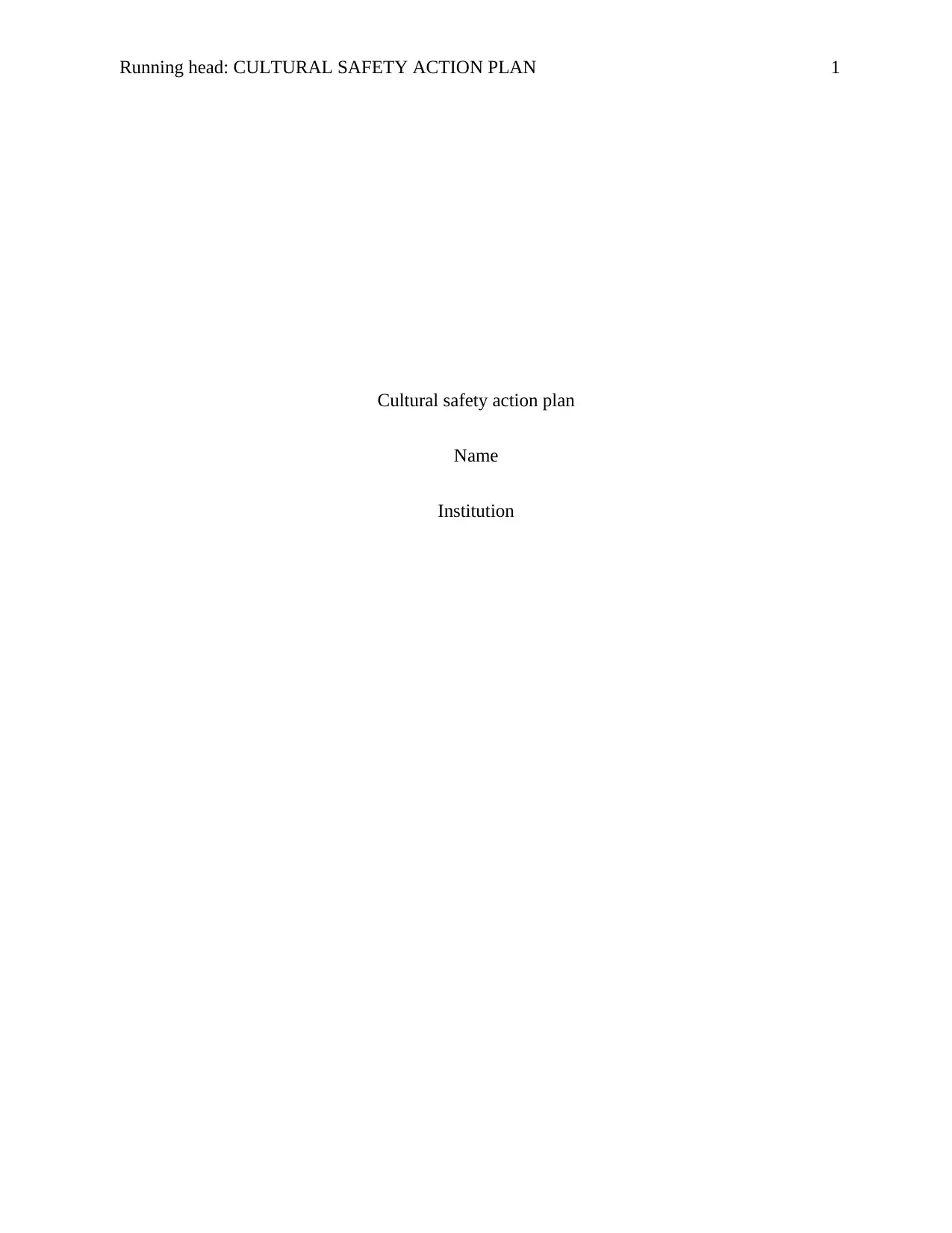
Running head: CULTURAL SAFETY ACTION PLAN 1
Cultural safety action plan
Name
Institution
Cultural safety action plan
Name
Institution
Paraphrase This Document
Need a fresh take? Get an instant paraphrase of this document with our AI Paraphraser
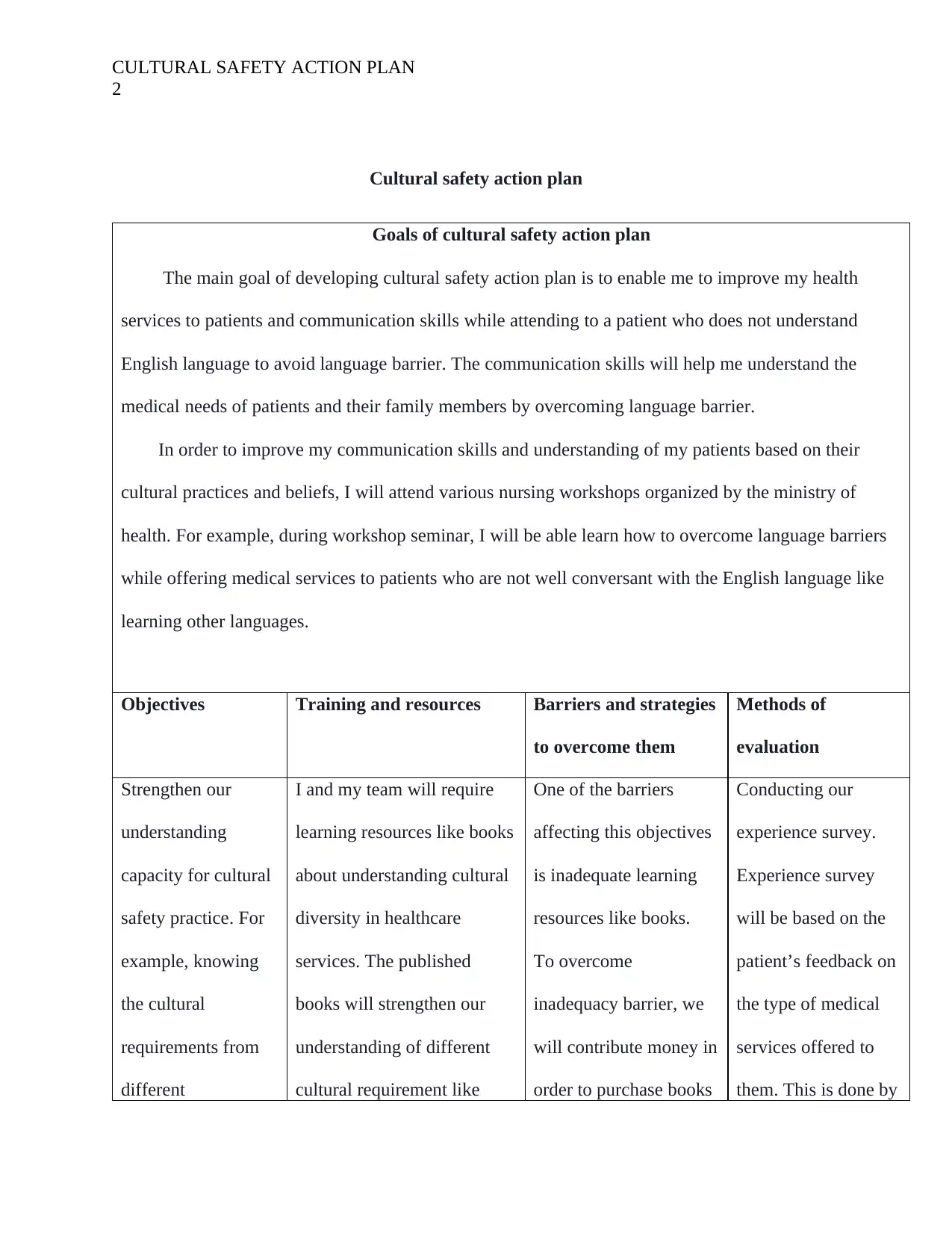
CULTURAL SAFETY ACTION PLAN
2
Cultural safety action plan
Goals of cultural safety action plan
The main goal of developing cultural safety action plan is to enable me to improve my health
services to patients and communication skills while attending to a patient who does not understand
English language to avoid language barrier. The communication skills will help me understand the
medical needs of patients and their family members by overcoming language barrier.
In order to improve my communication skills and understanding of my patients based on their
cultural practices and beliefs, I will attend various nursing workshops organized by the ministry of
health. For example, during workshop seminar, I will be able learn how to overcome language barriers
while offering medical services to patients who are not well conversant with the English language like
learning other languages.
Objectives Training and resources Barriers and strategies
to overcome them
Methods of
evaluation
Strengthen our
understanding
capacity for cultural
safety practice. For
example, knowing
the cultural
requirements from
different
I and my team will require
learning resources like books
about understanding cultural
diversity in healthcare
services. The published
books will strengthen our
understanding of different
cultural requirement like
One of the barriers
affecting this objectives
is inadequate learning
resources like books.
To overcome
inadequacy barrier, we
will contribute money in
order to purchase books
Conducting our
experience survey.
Experience survey
will be based on the
patient’s feedback on
the type of medical
services offered to
them. This is done by
2
Cultural safety action plan
Goals of cultural safety action plan
The main goal of developing cultural safety action plan is to enable me to improve my health
services to patients and communication skills while attending to a patient who does not understand
English language to avoid language barrier. The communication skills will help me understand the
medical needs of patients and their family members by overcoming language barrier.
In order to improve my communication skills and understanding of my patients based on their
cultural practices and beliefs, I will attend various nursing workshops organized by the ministry of
health. For example, during workshop seminar, I will be able learn how to overcome language barriers
while offering medical services to patients who are not well conversant with the English language like
learning other languages.
Objectives Training and resources Barriers and strategies
to overcome them
Methods of
evaluation
Strengthen our
understanding
capacity for cultural
safety practice. For
example, knowing
the cultural
requirements from
different
I and my team will require
learning resources like books
about understanding cultural
diversity in healthcare
services. The published
books will strengthen our
understanding of different
cultural requirement like
One of the barriers
affecting this objectives
is inadequate learning
resources like books.
To overcome
inadequacy barrier, we
will contribute money in
order to purchase books
Conducting our
experience survey.
Experience survey
will be based on the
patient’s feedback on
the type of medical
services offered to
them. This is done by
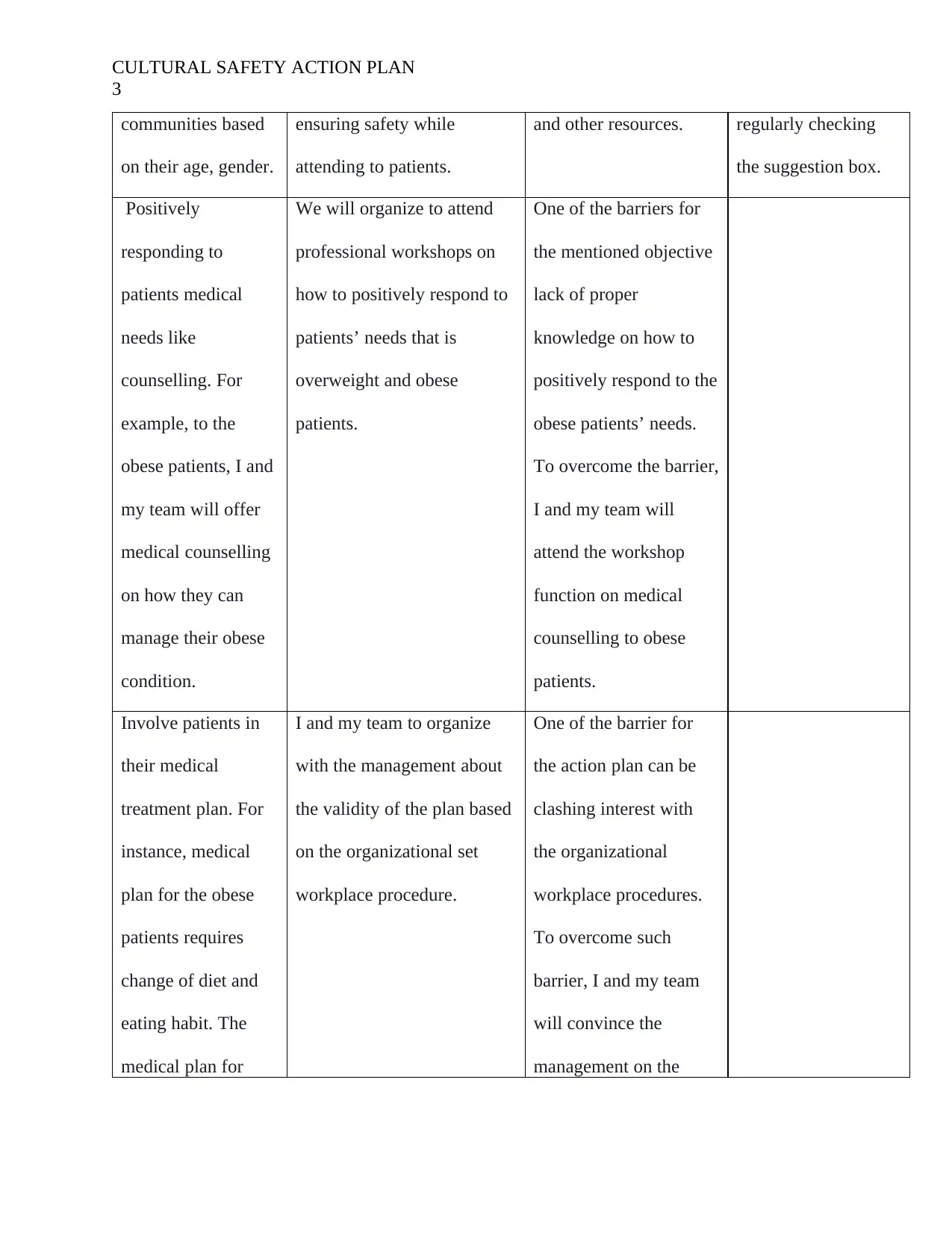
CULTURAL SAFETY ACTION PLAN
3
communities based
on their age, gender.
ensuring safety while
attending to patients.
and other resources. regularly checking
the suggestion box.
Positively
responding to
patients medical
needs like
counselling. For
example, to the
obese patients, I and
my team will offer
medical counselling
on how they can
manage their obese
condition.
We will organize to attend
professional workshops on
how to positively respond to
patients’ needs that is
overweight and obese
patients.
One of the barriers for
the mentioned objective
lack of proper
knowledge on how to
positively respond to the
obese patients’ needs.
To overcome the barrier,
I and my team will
attend the workshop
function on medical
counselling to obese
patients.
Involve patients in
their medical
treatment plan. For
instance, medical
plan for the obese
patients requires
change of diet and
eating habit. The
medical plan for
I and my team to organize
with the management about
the validity of the plan based
on the organizational set
workplace procedure.
One of the barrier for
the action plan can be
clashing interest with
the organizational
workplace procedures.
To overcome such
barrier, I and my team
will convince the
management on the
3
communities based
on their age, gender.
ensuring safety while
attending to patients.
and other resources. regularly checking
the suggestion box.
Positively
responding to
patients medical
needs like
counselling. For
example, to the
obese patients, I and
my team will offer
medical counselling
on how they can
manage their obese
condition.
We will organize to attend
professional workshops on
how to positively respond to
patients’ needs that is
overweight and obese
patients.
One of the barriers for
the mentioned objective
lack of proper
knowledge on how to
positively respond to the
obese patients’ needs.
To overcome the barrier,
I and my team will
attend the workshop
function on medical
counselling to obese
patients.
Involve patients in
their medical
treatment plan. For
instance, medical
plan for the obese
patients requires
change of diet and
eating habit. The
medical plan for
I and my team to organize
with the management about
the validity of the plan based
on the organizational set
workplace procedure.
One of the barrier for
the action plan can be
clashing interest with
the organizational
workplace procedures.
To overcome such
barrier, I and my team
will convince the
management on the
⊘ This is a preview!⊘
Do you want full access?
Subscribe today to unlock all pages.

Trusted by 1+ million students worldwide
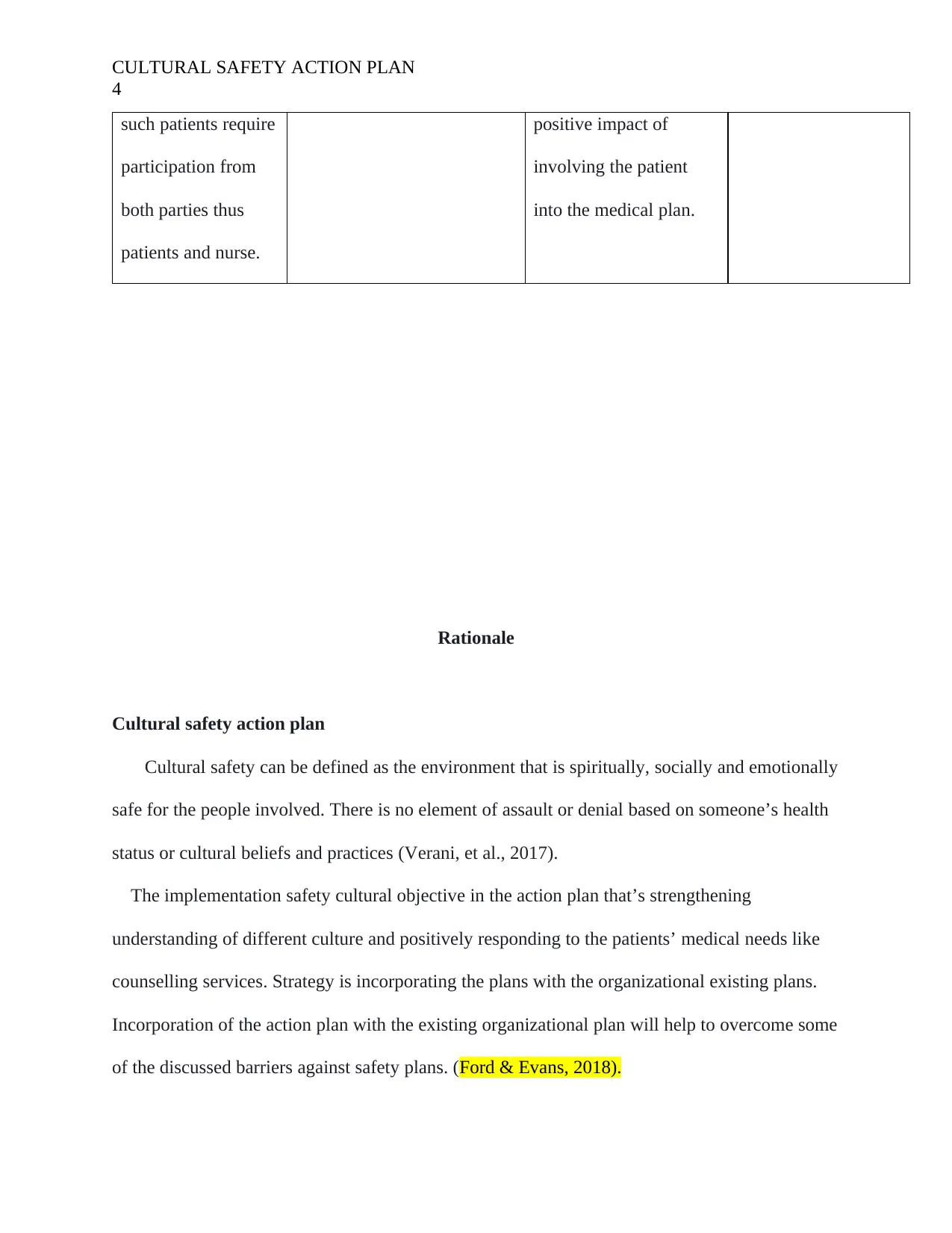
CULTURAL SAFETY ACTION PLAN
4
such patients require
participation from
both parties thus
patients and nurse.
positive impact of
involving the patient
into the medical plan.
Rationale
Cultural safety action plan
Cultural safety can be defined as the environment that is spiritually, socially and emotionally
safe for the people involved. There is no element of assault or denial based on someone’s health
status or cultural beliefs and practices (Verani, et al., 2017).
The implementation safety cultural objective in the action plan that’s strengthening
understanding of different culture and positively responding to the patients’ medical needs like
counselling services. Strategy is incorporating the plans with the organizational existing plans.
Incorporation of the action plan with the existing organizational plan will help to overcome some
of the discussed barriers against safety plans. (Ford & Evans, 2018).
4
such patients require
participation from
both parties thus
patients and nurse.
positive impact of
involving the patient
into the medical plan.
Rationale
Cultural safety action plan
Cultural safety can be defined as the environment that is spiritually, socially and emotionally
safe for the people involved. There is no element of assault or denial based on someone’s health
status or cultural beliefs and practices (Verani, et al., 2017).
The implementation safety cultural objective in the action plan that’s strengthening
understanding of different culture and positively responding to the patients’ medical needs like
counselling services. Strategy is incorporating the plans with the organizational existing plans.
Incorporation of the action plan with the existing organizational plan will help to overcome some
of the discussed barriers against safety plans. (Ford & Evans, 2018).
Paraphrase This Document
Need a fresh take? Get an instant paraphrase of this document with our AI Paraphraser
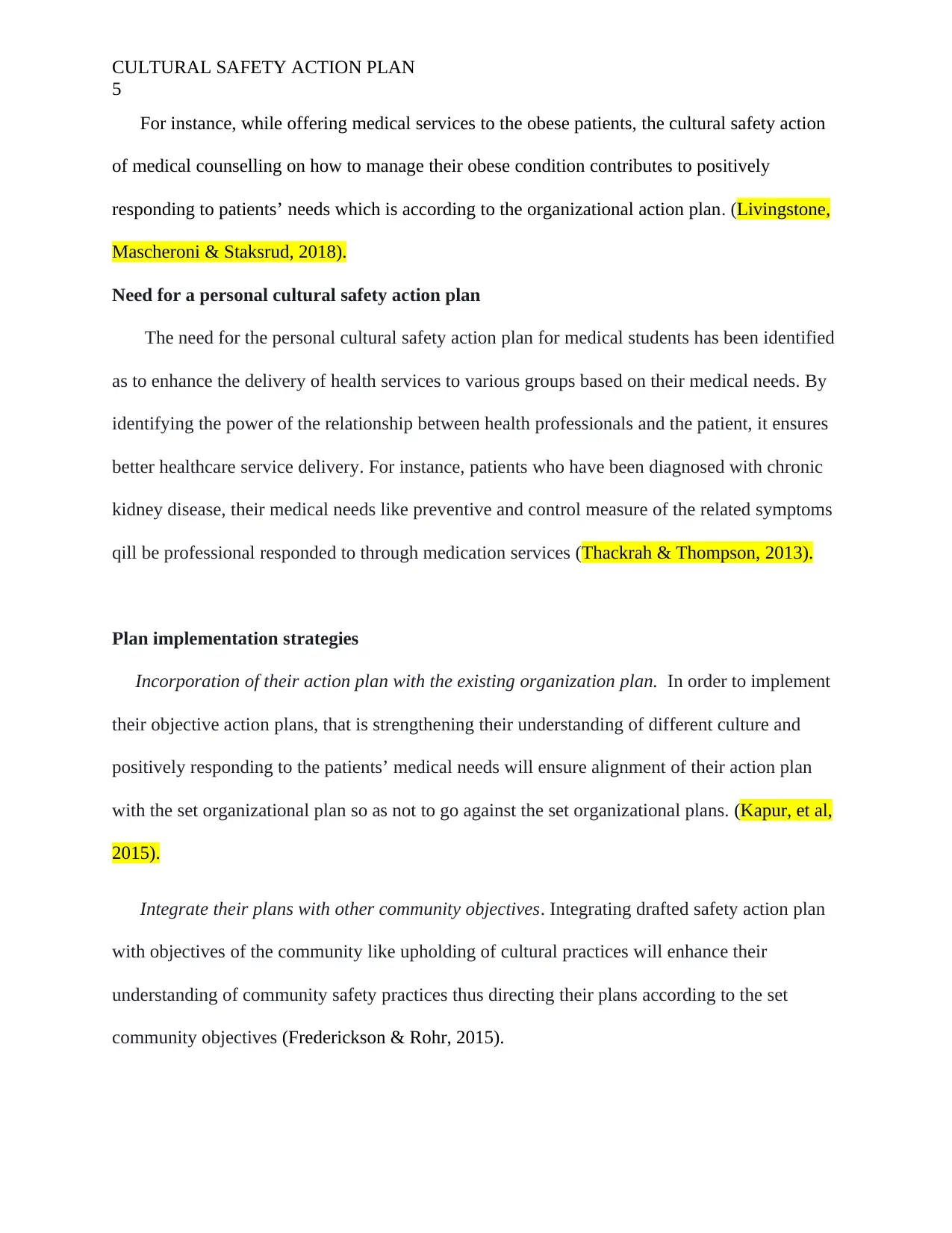
CULTURAL SAFETY ACTION PLAN
5
For instance, while offering medical services to the obese patients, the cultural safety action
of medical counselling on how to manage their obese condition contributes to positively
responding to patients’ needs which is according to the organizational action plan. (Livingstone,
Mascheroni & Staksrud, 2018).
Need for a personal cultural safety action plan
The need for the personal cultural safety action plan for medical students has been identified
as to enhance the delivery of health services to various groups based on their medical needs. By
identifying the power of the relationship between health professionals and the patient, it ensures
better healthcare service delivery. For instance, patients who have been diagnosed with chronic
kidney disease, their medical needs like preventive and control measure of the related symptoms
qill be professional responded to through medication services (Thackrah & Thompson, 2013).
Plan implementation strategies
Incorporation of their action plan with the existing organization plan. In order to implement
their objective action plans, that is strengthening their understanding of different culture and
positively responding to the patients’ medical needs will ensure alignment of their action plan
with the set organizational plan so as not to go against the set organizational plans. (Kapur, et al,
2015).
Integrate their plans with other community objectives. Integrating drafted safety action plan
with objectives of the community like upholding of cultural practices will enhance their
understanding of community safety practices thus directing their plans according to the set
community objectives (Frederickson & Rohr, 2015).
5
For instance, while offering medical services to the obese patients, the cultural safety action
of medical counselling on how to manage their obese condition contributes to positively
responding to patients’ needs which is according to the organizational action plan. (Livingstone,
Mascheroni & Staksrud, 2018).
Need for a personal cultural safety action plan
The need for the personal cultural safety action plan for medical students has been identified
as to enhance the delivery of health services to various groups based on their medical needs. By
identifying the power of the relationship between health professionals and the patient, it ensures
better healthcare service delivery. For instance, patients who have been diagnosed with chronic
kidney disease, their medical needs like preventive and control measure of the related symptoms
qill be professional responded to through medication services (Thackrah & Thompson, 2013).
Plan implementation strategies
Incorporation of their action plan with the existing organization plan. In order to implement
their objective action plans, that is strengthening their understanding of different culture and
positively responding to the patients’ medical needs will ensure alignment of their action plan
with the set organizational plan so as not to go against the set organizational plans. (Kapur, et al,
2015).
Integrate their plans with other community objectives. Integrating drafted safety action plan
with objectives of the community like upholding of cultural practices will enhance their
understanding of community safety practices thus directing their plans according to the set
community objectives (Frederickson & Rohr, 2015).
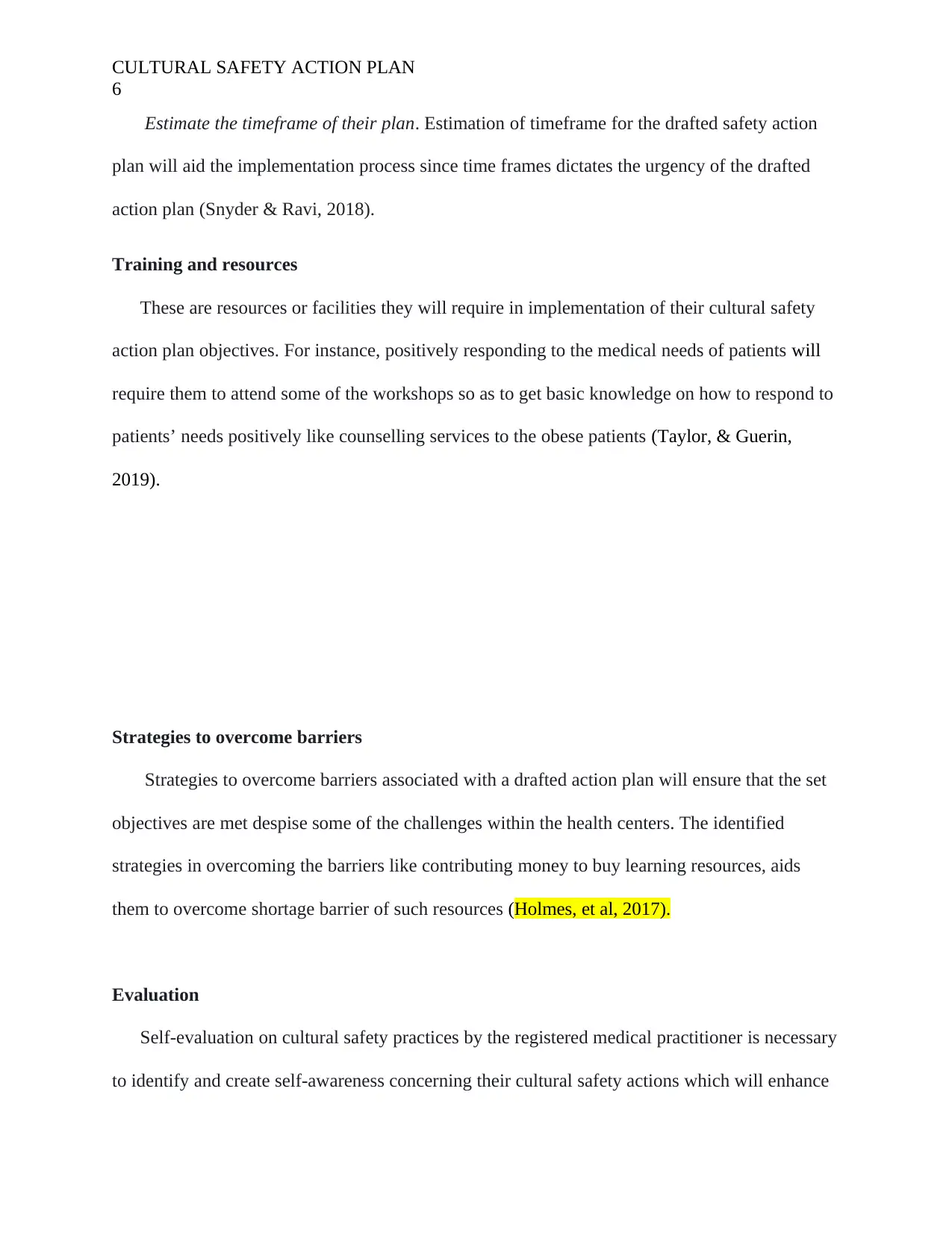
CULTURAL SAFETY ACTION PLAN
6
Estimate the timeframe of their plan. Estimation of timeframe for the drafted safety action
plan will aid the implementation process since time frames dictates the urgency of the drafted
action plan (Snyder & Ravi, 2018).
Training and resources
These are resources or facilities they will require in implementation of their cultural safety
action plan objectives. For instance, positively responding to the medical needs of patients will
require them to attend some of the workshops so as to get basic knowledge on how to respond to
patients’ needs positively like counselling services to the obese patients (Taylor, & Guerin,
2019).
Strategies to overcome barriers
Strategies to overcome barriers associated with a drafted action plan will ensure that the set
objectives are met despise some of the challenges within the health centers. The identified
strategies in overcoming the barriers like contributing money to buy learning resources, aids
them to overcome shortage barrier of such resources (Holmes, et al, 2017).
Evaluation
Self-evaluation on cultural safety practices by the registered medical practitioner is necessary
to identify and create self-awareness concerning their cultural safety actions which will enhance
6
Estimate the timeframe of their plan. Estimation of timeframe for the drafted safety action
plan will aid the implementation process since time frames dictates the urgency of the drafted
action plan (Snyder & Ravi, 2018).
Training and resources
These are resources or facilities they will require in implementation of their cultural safety
action plan objectives. For instance, positively responding to the medical needs of patients will
require them to attend some of the workshops so as to get basic knowledge on how to respond to
patients’ needs positively like counselling services to the obese patients (Taylor, & Guerin,
2019).
Strategies to overcome barriers
Strategies to overcome barriers associated with a drafted action plan will ensure that the set
objectives are met despise some of the challenges within the health centers. The identified
strategies in overcoming the barriers like contributing money to buy learning resources, aids
them to overcome shortage barrier of such resources (Holmes, et al, 2017).
Evaluation
Self-evaluation on cultural safety practices by the registered medical practitioner is necessary
to identify and create self-awareness concerning their cultural safety actions which will enhance
⊘ This is a preview!⊘
Do you want full access?
Subscribe today to unlock all pages.

Trusted by 1+ million students worldwide
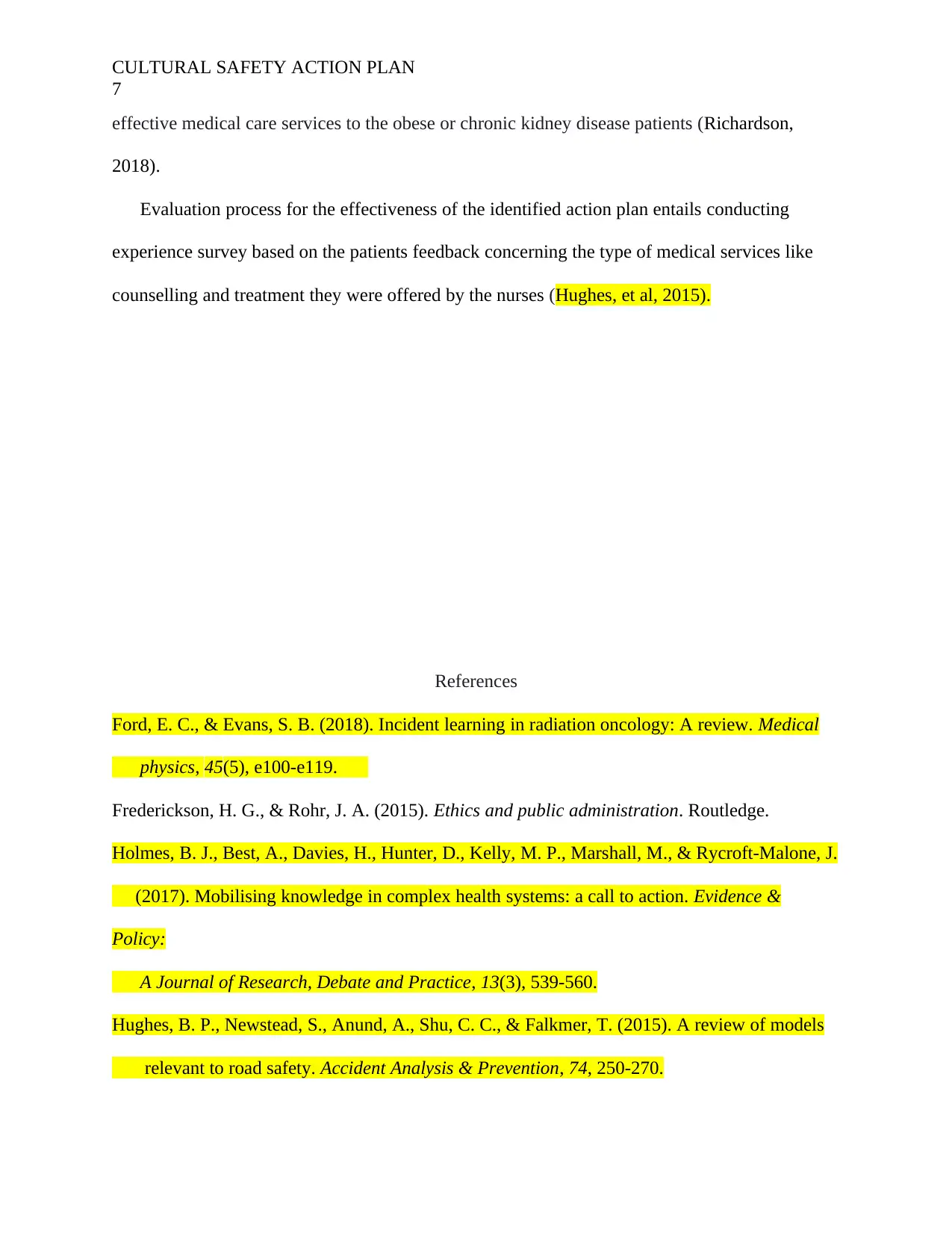
CULTURAL SAFETY ACTION PLAN
7
effective medical care services to the obese or chronic kidney disease patients (Richardson,
2018).
Evaluation process for the effectiveness of the identified action plan entails conducting
experience survey based on the patients feedback concerning the type of medical services like
counselling and treatment they were offered by the nurses (Hughes, et al, 2015).
References
Ford, E. C., & Evans, S. B. (2018). Incident learning in radiation oncology: A review. Medical
physics, 45(5), e100-e119.
Frederickson, H. G., & Rohr, J. A. (2015). Ethics and public administration. Routledge.
Holmes, B. J., Best, A., Davies, H., Hunter, D., Kelly, M. P., Marshall, M., & Rycroft-Malone, J.
(2017). Mobilising knowledge in complex health systems: a call to action. Evidence &
Policy:
A Journal of Research, Debate and Practice, 13(3), 539-560.
Hughes, B. P., Newstead, S., Anund, A., Shu, C. C., & Falkmer, T. (2015). A review of models
relevant to road safety. Accident Analysis & Prevention, 74, 250-270.
7
effective medical care services to the obese or chronic kidney disease patients (Richardson,
2018).
Evaluation process for the effectiveness of the identified action plan entails conducting
experience survey based on the patients feedback concerning the type of medical services like
counselling and treatment they were offered by the nurses (Hughes, et al, 2015).
References
Ford, E. C., & Evans, S. B. (2018). Incident learning in radiation oncology: A review. Medical
physics, 45(5), e100-e119.
Frederickson, H. G., & Rohr, J. A. (2015). Ethics and public administration. Routledge.
Holmes, B. J., Best, A., Davies, H., Hunter, D., Kelly, M. P., Marshall, M., & Rycroft-Malone, J.
(2017). Mobilising knowledge in complex health systems: a call to action. Evidence &
Policy:
A Journal of Research, Debate and Practice, 13(3), 539-560.
Hughes, B. P., Newstead, S., Anund, A., Shu, C. C., & Falkmer, T. (2015). A review of models
relevant to road safety. Accident Analysis & Prevention, 74, 250-270.
Paraphrase This Document
Need a fresh take? Get an instant paraphrase of this document with our AI Paraphraser
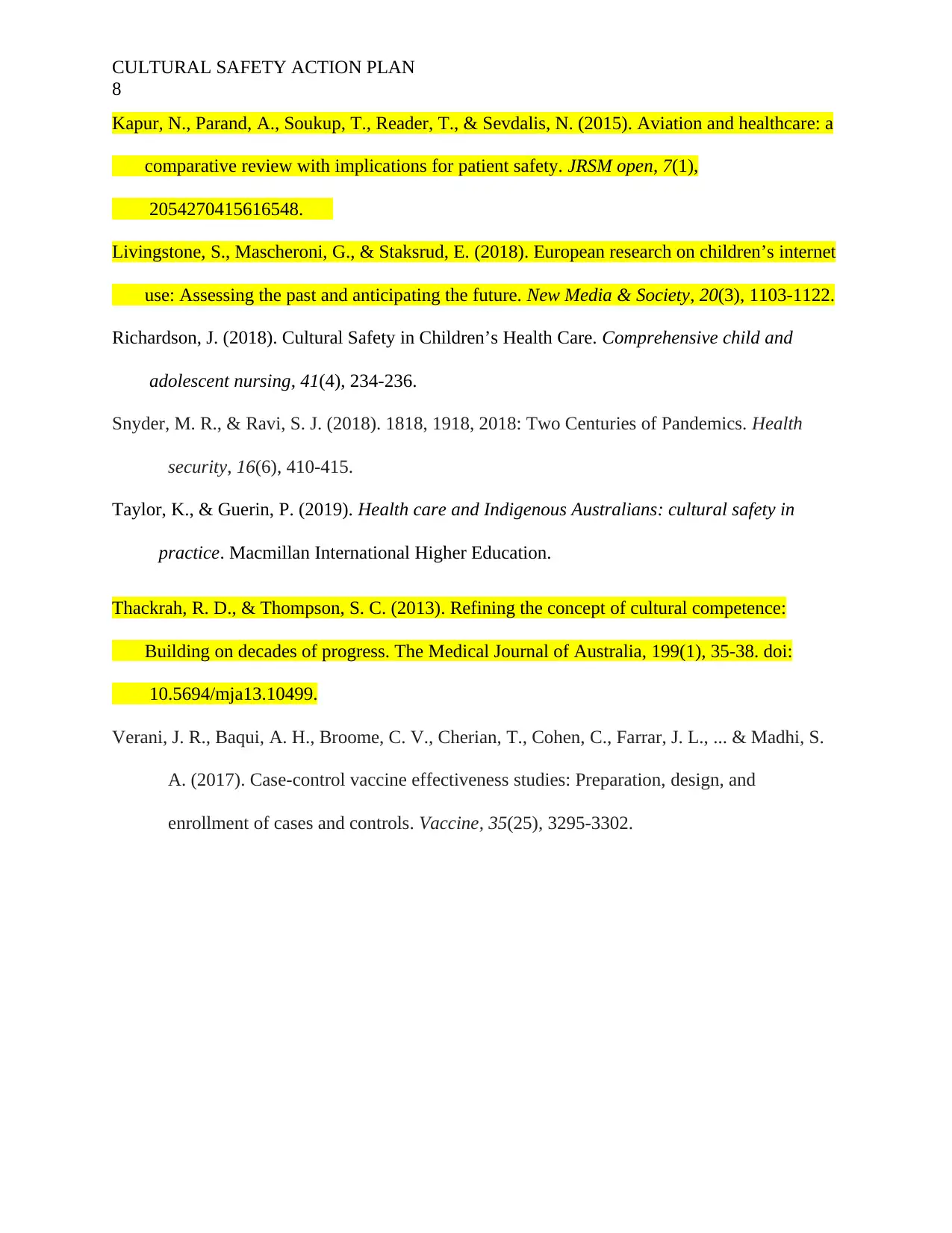
CULTURAL SAFETY ACTION PLAN
8
Kapur, N., Parand, A., Soukup, T., Reader, T., & Sevdalis, N. (2015). Aviation and healthcare: a
comparative review with implications for patient safety. JRSM open, 7(1),
2054270415616548.
Livingstone, S., Mascheroni, G., & Staksrud, E. (2018). European research on children’s internet
use: Assessing the past and anticipating the future. New Media & Society, 20(3), 1103-1122.
Richardson, J. (2018). Cultural Safety in Children’s Health Care. Comprehensive child and
adolescent nursing, 41(4), 234-236.
Snyder, M. R., & Ravi, S. J. (2018). 1818, 1918, 2018: Two Centuries of Pandemics. Health
security, 16(6), 410-415.
Taylor, K., & Guerin, P. (2019). Health care and Indigenous Australians: cultural safety in
practice. Macmillan International Higher Education.
Thackrah, R. D., & Thompson, S. C. (2013). Refining the concept of cultural competence:
Building on decades of progress. The Medical Journal of Australia, 199(1), 35-38. doi:
10.5694/mja13.10499.
Verani, J. R., Baqui, A. H., Broome, C. V., Cherian, T., Cohen, C., Farrar, J. L., ... & Madhi, S.
A. (2017). Case-control vaccine effectiveness studies: Preparation, design, and
enrollment of cases and controls. Vaccine, 35(25), 3295-3302.
8
Kapur, N., Parand, A., Soukup, T., Reader, T., & Sevdalis, N. (2015). Aviation and healthcare: a
comparative review with implications for patient safety. JRSM open, 7(1),
2054270415616548.
Livingstone, S., Mascheroni, G., & Staksrud, E. (2018). European research on children’s internet
use: Assessing the past and anticipating the future. New Media & Society, 20(3), 1103-1122.
Richardson, J. (2018). Cultural Safety in Children’s Health Care. Comprehensive child and
adolescent nursing, 41(4), 234-236.
Snyder, M. R., & Ravi, S. J. (2018). 1818, 1918, 2018: Two Centuries of Pandemics. Health
security, 16(6), 410-415.
Taylor, K., & Guerin, P. (2019). Health care and Indigenous Australians: cultural safety in
practice. Macmillan International Higher Education.
Thackrah, R. D., & Thompson, S. C. (2013). Refining the concept of cultural competence:
Building on decades of progress. The Medical Journal of Australia, 199(1), 35-38. doi:
10.5694/mja13.10499.
Verani, J. R., Baqui, A. H., Broome, C. V., Cherian, T., Cohen, C., Farrar, J. L., ... & Madhi, S.
A. (2017). Case-control vaccine effectiveness studies: Preparation, design, and
enrollment of cases and controls. Vaccine, 35(25), 3295-3302.
1 out of 8
Related Documents
Your All-in-One AI-Powered Toolkit for Academic Success.
+13062052269
info@desklib.com
Available 24*7 on WhatsApp / Email
![[object Object]](/_next/static/media/star-bottom.7253800d.svg)
Unlock your academic potential
Copyright © 2020–2025 A2Z Services. All Rights Reserved. Developed and managed by ZUCOL.





